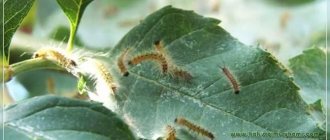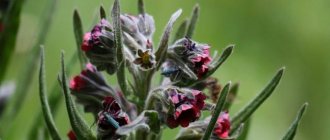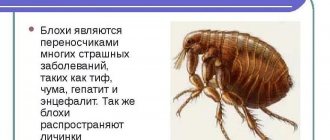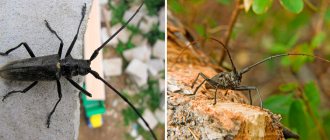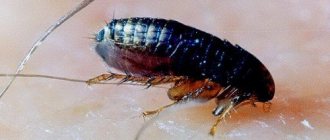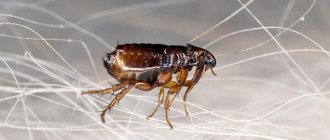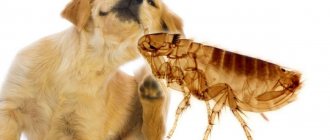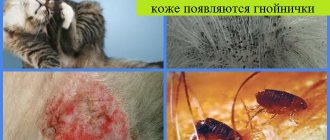Today, approximately 500 specific species of fleas live in the Russian Federation. The most common of them are those insects that live on pets (cats, dogs - Ctenocephalides canis, Ctenocephalides felis, etc.), as well as on rats or humans (for example, Pulex irritans).
About 30 species of these small pests live in private households or apartments. The size of 1 insect is 1–5 mm.
Most people do not know how the different types of fleas reproduce. This and other nuances are discussed in detail below in this article.
How fleas are fertilized and reproduce
How are fleas fertilized and reproduce? They have a specific reproductive system.
Mating of similar insects Pulex irritans, Ctenocephalides felis, Ctenocephalides canis or Xenopsylla cheopis lasts a maximum of 10 hours. They almost always copulate with each other after they have drunk a large amount of blood from a particular host.
What is the reproduction rate of various flea species (Pulex irritans, Ctenocephalides canis, Xenopsylla cheopis, etc.)? After mating with the male, the female flea begins to lay eggs. Then she puts away up to 10 pieces at a time.
The total number of flea eggs from 1 female is more than 500 pieces per 1 life cycle. Such small pests copulate with each other in comfortable conditions.
Females breed in dust, on various rags, certain woolen products, genital crevices, dog kennels, clothes or other places hidden from prying eyes.
Flea eggs are covered with a white shell and also have an oval shape. They are similar to grains of rice, but are significantly smaller in size.
Description of fleas: lifestyle, body structure
Fleas belong to the order of blood-sucking arthropods. The length of the parasite can reach 5 mm, females after feeding grow up to 1 cm, fertilized ones - up to 1.5 cm. The body of the flea consists of a head and abdomen covered with chitinous cover, the body is flattened on the sides. Thanks to this shape, the insect easily moves among feathers, fur and clothing. Color ranges from yellow to almost black.
Interesting! During the process of evolution, many animals have changed in appearance. Scientists have found that the modern flea looks almost the same as its ancestors.
Fleas do not have wings, and they move by jumping with the help of three pairs of long and strong limbs. Some species have shorter paws, so they are constantly on the host's body. The paw consists of five segments and ends with sharp bristles-claws, forked at the end.
The flea's body is covered with spines and bristles, which helps it move very quickly throughout the victim's body. The head has serrated ridges. Due to this structure, the parasite cannot be combed out, chewed out or removed; it can only be crushed with a fingernail.
At the back of the abdomen is the pygidium, a sensory organ covered with tactile hairs. They react to small changes in air and warn of danger.
The reproductive system of the female consists of the oviduct, ovaries and spermatic receptacle (in the shape of a curved flask), and of the males - the genital claw (copulatory organ).
There are antennas behind the eyes. With them, males hold onto females during mating. The rest of the time they are in the antennal fossae.
The type of oral cavity is piercing-sucking. After biting the skin, the flea enlarges the wound, secretes saliva, which prevents blood clotting, then penetrates deeper and moves to the blood vessel, where it sucks blood. A flea cannot crawl completely under the skin.
Flea lifespan
How long does the most common human flea, Pulex irritans, live? In a favorable environment, this insect lives for about 3 months.
During this period, 1 female of this bloodsucker lays 400–600 small eggs, and each such small pest makes about 100 bites. Only after this minimal “plan” is completed does this parasite die naturally.
An important condition for comfortable living of fleas is compliance with specific air humidity and temperature. Thus, rat-like insects Xenopsylla cheopis live quietly inside any room at 14 degrees Celsius and 55% humidity or more.
Bloodsuckers that live in a private household or apartment (Pulex irritans, Ctenocephalides felis or Ctenocephalides canis) also feel good there. However, they die quickly without immediate access to blood.
If these insects live in places with elevated temperatures, then all their phases of reproduction and development pass much faster. Thus, adults become very large.
Typically, flea larvae of pulex irritans degenerate into an adult in 30 days, while at elevated temperatures the fleas multiply and then grow much faster - in 7 days. The development of flea eggs ends after 14 days, and then for another 14 days this small pest is in the pupal phase.
These bloodsuckers, who live not in a warm home, but in nature, die quickly. After all, they are destroyed by the carriers themselves (dogs, cats, etc.). Then the animals bite the bloodsuckers out of their fur.
Also, many such bloodsuckers die from various infections. There are fleas that change several hosts during their life when the animal dies.
Fleas Ctenocephalides felis, Ctenocephalides canis immediately leave a dead dog or cat because they cannot feed on the blood of a dead animal.
How long do these insects live?
How long do various species of bloodsuckers live (for example, Pulex irritans, Ctenocephalides felis, Ctenocephalides canis, Xenopsylla cheopis, etc.)?
The lifespan of all types of fleas is directly related to these 3 factors:
- specific temperature regime;
- living conditions - apartment or street;
- air humidity.
On average, these small pests live 18–90 days. Throughout its life, 1 bloodsucker makes about 10 bites and, thus, it injures its owner.
Over the course of her entire life, a female flea lays about 500 eggs.
However, these bloodsuckers often die from various infections that they themselves spread, as well as from the teeth of a domestic cat or dog, from human hands or any disinfectant.
Can parasites live without food?
How long do fleas live without food? Approximately 2–3 months. the parasites Pulex irritans, Ctenocephalides felis, Ctenocephalides canis or Xenopsylla cheopis can live without consuming blood.
Especially those individuals that often bite humans. At the same time, they remain mobile.
However, if these insects do not feed for a long time, they do not reproduce in any way. After all, only after a hearty lunch do they mate with each other, and then the female flea lays many small eggs.
Do these bloodsuckers live in a private household or apartment if there are no animals or people there? Yes, but not indefinitely. Sooner or later they still die.
What determines the lifespan of a flea?
At the moment, it is the sharp change in air temperature that greatly affects the lifespan of fleas.
In addition to it, the lifespan of such bloodsuckers Pulex irritans, Ctenocephalides felis, Ctenocephalides canis or Xenopsylla cheopis is directly related to the following factors:
- air humidity. Low (but not too low) humidity is comfortable for bloodsuckers;
- source of food. Small pests that do not receive fresh animal or human blood for a long time live longer;
- the invariability of specific temperature and humidity conditions.
Bloodsuckers that live in areas with constant sharp changes in humidity and fluctuations in street temperature often quickly become numb. This significantly increases the life span of a flea.
An important factor for fleas is the number of offspring produced from 1 female, and not the rate of formation of flea larvae. As a rule, such a process is continuous.
Thus, while fighting various bloodsuckers, the lodger not only removes these parasites from the pet’s fur, but also destroys flea larvae hidden in secluded places.
How long does a flea live?
The optimal temperature for flea development is 18–27 degrees, and the most suitable humidity is 70–100%. Under such conditions, the flea grows in 20–49 days .
If the humidity drops below 60%, then the larvae stop the development process, and they completely die in the water .
It is interesting that if environmental conditions cannot be called favorable, then the period when the flea remains sealed in a cocoon may be significantly longer.
The main part of fleas are temporary parasites that use domestic animals and humans only to get enough food in order to continue their life activities.
Habitats of bloodsuckers in the apartment and in nature
Where do fleas live?
In an apartment, the parasites Pulex irritans, Ctenocephalides felis or Ctenocephalides canis settle and live for a long time in the following places:
- in bedding for domestic cats, dogs or other pets;
- on carpeted surfaces. Then flea eggs accumulate on the carpets;
- on sofa upholstery and outer covering of chairs;
- on a variety of soft toys for children;
- on old clothes;
- on mattresses;
- in bed linen;
- behind room or other apartment skirting boards;
- under the linoleum.
Outdoors, these small pests live close to a variety of animals (hamsters, rabbits, rats, etc.), which provide them with a source of food.
Fleas infest and lay their eggs and larvae in trash cans, basements, sand piles, bird nests, or inside the burrows of various animals.
Household fleas that live near people are divided into the following types of insects:
- bloodsuckers from pets - Ctenocephalides felis and Ctenocephalides canis;
- rat or mouse parasites - Xenopsylla cheopis, etc.;
- ground or basement bloodsuckers - for example, Vermipsylla alakurt;
- bed insects, etc.
Such bloodsuckers are small insects that cause a lot of problems for animals or humans. Their bites are very painful, after which itching and skin irritation form on the fur of a cat or dog, as well as on human skin.
In addition, the bloodsuckers Pulex irritans, Ctenocephalides felis or Ctenocephalides canis carry many unpleasant ailments. Therefore, it is important for a person to get rid of them in a timely manner - to destroy not only the fur of pets, but also to remove them from open or hidden corners of the apartment.
Can small pests live on the sofa and on clothes?
At home, the most common human flea, Pulex irritans, often lives on sofas, carpets, clothing or bedding. They also live behind room and other baseboards, as well as in wall cracks.
These small pests Pulex irritans like to live in comfortable conditions.
These bloodsuckers love to live and copulate on the warm carpet pile, where they sit out after satiation.
In ancient times, rich people made such anti-flea traps: they hung small pieces of natural concrete wool on their bare legs to lure bloodsuckers Pulex irritans, Ctenocephalides felis or Ctenocephalides canis, and then burned them.
Can bloodsuckers live on the body and on human hair?
Unlike various lice, human fleas Pulex irritans, which are infested in a private house or apartment, do not live on the skin or hair for a long time. After all, after being saturated with human blood, they immediately leave the human body.
If the bloodsucker is distracted while eating, it lingers for some time on the clothing on the underside.
Sometimes these small pests remain on summer or other clothing for 1–2 days. Then the Pulex irritans fleas periodically bite the person. However, they do not use humans as their daily hosts because little hair grows on them.
Laboratory studies by biologists have shown that bloodsuckers Pulex irritans live and reproduce quietly after consuming human blood. But more often, these small pests rarely attack people, and also do not copulate on their body.
The fact is that these insects are immediately very noticeable on human skin, and people immediately shake them off. In addition, it is difficult for them to move around a person, because their bristly small body is adapted to a comfortable life only on thick animal fur.
Human fleas, Pulex irritans, do not typically lay multiple eggs in hair. Firstly, these small pests often simply do not reach the head - they jump at most to ankle level.
And secondly, when they come into contact with a person, such bloodsuckers immediately bite him, and then immediately get out of the way.
Lifestyle and behavioral characteristics
Most often, fleas parasitize animals that have a permanent shelter. Those who use a nest, burrow or other shelter occasionally from time to time are less likely to be attacked by bloodsuckers. Usually the flea does not live permanently on the victim's body. She jumps on it to feed and then returns to the litter of the nest or burrow.
Infected animals
There are so-called “stationary” ectoparasites. They parasitize animals that have no shelter. In order not to lose the owner, such fleas do not leave his body. Most often this applies to fleas of marsupials and artiodactyl mammals. Another reason for permanent residence on the victim’s body is the need for regular nutrition.
The vast majority of fleas are not too picky in choosing a victim and can parasitize various animals. The exception is fleas of bats, which recognize only this species of animal as a host.
How bloodsuckers get into an apartment
Will fleas live in the apartment in winter or not? Most likely not, because they are more likely to start in residential areas in the summer or autumn. At the same time, they often inhabit the lower floors of apartment buildings or private households.
Ground-like insects inhabit very dusty rooms or abandoned various buildings.
The fleas Pulex irritans, Ctenocephalides felis or Ctenocephalides canis enter an apartment or private house in this way:
- from the entrance of an apartment building;
- enter the home from neighbors;
- they are brought in by domestic animals;
- They infect a certain home with various rodents.
If the basement is always damp, then flea breeding often begins in this place. After all, the most common human flea, Pulex irritans, loves dampness. Also, these small pests multiply quickly inside well-heated living spaces.
If a person does not ventilate his apartment for a long time, and there is always a lot of garbage in it and sunlight does not enter inside, then the bloodsuckers Pulex irritans quickly infest and multiply in this home.
Due to their small size, these parasites enter the home through small cracks in the apartment.
In addition, various species of fleas (for example, Ctenocephalides canis, etc.) do not always live on their host. They live comfortably on baseboards, floor crevices, linoleum, carpet, as well as on pieces of furniture, clothing or a variety of soft toys.
Video
Flea infestations of your pet and home
Where do fleas live?
A very large number of flea species are determined by suitable climatic conditions. It is a common belief that the number of fleas varies depending on the time of year.
When a cold period sets in, the number rarely decreases, and, conversely , with the arrival of warmth, insects actively reproduce. The hot months of summer seem to be especially active in this regard.
The greatest danger comes from fleas that live in the apartment and can cause harm to them. Fleas often settle near rodent burrows . As for residential premises, they are most often found in small cracks on the floor , under bedspreads and in dusty places where people cannot penetrate.
Find out where fleas come from in the house?
Remarkable is the fact that a female flea is capable of laying about 400 eggs in her entire life.
Why are these bloodsuckers needed?
At the moment, there are many species of fleas (Pulex irritans, Ctenocephalides felis, Ctenocephalides canis, Xenopsylla cheopis, etc.). Without these small pests, many animals would simply die out.
After all, these bloodsuckers are part of the specific food chain of various animals. Also, these bloodsuckers transfer various diseases from one carrier to another.
Thus, blood-sucking insects (fleas) are useful not for people, but for certain viral microorganisms.
The role of such a bloodsucker in nature comes down to the fact that it is a parasite. Thus, this insect shortens the life of its “carrier” (cat, dog, etc.).
In general, fleas have a positive meaning in nature, but they are more likely an epidemic. Often these small pests are the causative agents and first carriers of various epidemiological infections.
According to numerous laboratory studies by biologists, this bloodsucker simultaneously carries 30 types of specific viruses and bacteria.
Fortunately, not all such insects have the same ability to transmit various pathogens (plague, typhoid, etc.). It all depends on the diet, type and physical condition of the bloodsucker.
Life cycle of a flea
On average, fleas Pulex irritans, Ctenocephalides felis, Ctenocephalides canis, Xenopsylla cheopis or other types of similar bloodsuckers live 1-1.5 years. Moreover, they remain in the pupal stage for a very long time - under not the most favorable temperature conditions, bloodsuckers remain in this state for several months.
Even when this small pest becomes an adult and enters the adult stage, it continues to live in its small cocoon and waits for a specific moment for further hatching.
The life span of a flea directly depends on their type and size of the flea, food and living conditions in the natural or other environment. Most often, such bloodsuckers live for about 6 months. During this time, this small pest bites its “carrier” more than 200 times.
The life cycle of a human or other flea consists of 4 stages of development:
- the birth of a bloodsucker in an egg;
- the appearance of flea larvae;
- transformation of an insect into a pupa;
- hatching from the pupa into an adult flea - “imago”.
These small pests, like certain other parasites, also go through the 2nd above-mentioned stage of development of a cat or other flea - the appearance of a larva.
What do the larvae of these bloodsuckers look like? The flea larva has sharp small jaws that gnaw the egg from the inside.
Larvae of small pests Pulex irritans die due to the following factors:
- low or high air temperature - about -50 or above +40 degrees Celsius, respectively;
- constant exposure to water;
- daily exposure to direct sunlight.
Reproduction
Complete metamorphosis is how fleas develop. This means that the egg that hatches as an adult first produces a larva. This larva then turns into a pupa. The larvae do not pose a great danger and are not capable of causing harm .
This is only a transitional stage, the final goal of which is an adult insect, which in the scientific world is called an imago. It is these latter that support their vital functions by feeding on the blood of animals and people.
An adult flea produces eggs that have a dry surface and usually fall into the insect's nest or onto the floor. The larvae, which emerge from the eggs after some time, are whitish in color and have no legs or organs of vision .
They can be observed in cracks in coverings or in carpets. If their direct carrier lives in the basement, then attention should be paid, first of all, to heaps of garbage and various household rubbish.
Flea larvae that threaten cats, dogs and humans sometimes settle on green lawns . There they have the opportunity to receive nutrition from plant juice.
Also, they are thus protected from the harmful effects of sunlight. Very often, owners of farms where pigs are raised become victims of fleas.
The egg development period ranges from several days to several weeks depending on environmental conditions. The life cycle of the larva is approximately two to four weeks.
When this period ends, the larva begins to construct a cobweb cocoon, which becomes its refuge until the time comes for rebirth into an adult flea, capable of obtaining its own food on its own.
Read more about flea reproduction.
The insect can remain in a clogged state for up to several months . It often happens that even the imago does not want to crawl out of the protective cocoon and does this only when it senses a potential victim.
What do parasites eat?
What do the fleas Pulex irritans, Ctenocephalides felis, Xenopsylla cheopis and other species of these insects eat every day? These small pests have a small mouth proboscis through which they drink blood from a particular animal or person.
Compared to many other bloodsuckers, for these insects blood proteins are the main food.
Both females and males are parasites. After puncturing the skin, the bloodsucker releases special specific substances that simultaneously stop blood clotting and activate blood flow.


